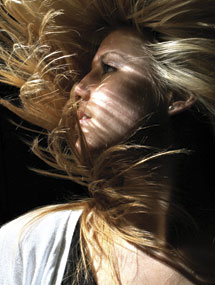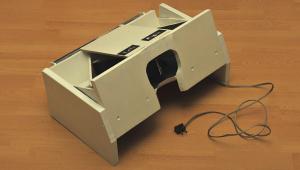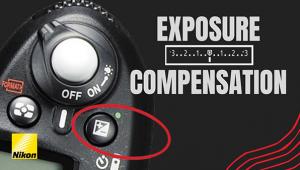There are still a lot of things to learn with these things especially in photography. - Larry Starr Sarasota
Tech Talk; Fill Flash Outdoors; Creative Lighting Techniques Page 2
The purpose of a snoot is to focus the flash’s light beam, directing the power toward the center of the light. A normal flash head has a very limited zoom range, from 28mm to 105mm. Shooting with a wide-angle lens larger than 28mm with flash will result in a brighter circle in the center with vignetted edges (necessitating bounce or diffusion). On the other end of the spectrum, when using lenses longer than 105mm a lot of flash power is wasted outside of the range of the subject. To overcome the light loss, the beam needs to be more tightly focused with a snoot. To intensify the light from a snoot, I often add a honeycomb grid (#4) to create an even greater, concentrated spotlight effect.
 |
||
|
||
One interesting effect can be created by increasing the relative power of the flash to ambient light, in essence underexposing the ambient light and using the flash as the main, or more powerful source. Even at 1⁄250 sec exposure, a sunny day will become darker, nearly simulating nightfall, while the snoot-powered flash maintains picture-perfect lighting on the face. This image (#5) was taken on a Canon EOS 7D with a 16-35mm lens, ISO 100, 1⁄250 sec at f/16, shot with the flash on the Manual setting at full power.
 |
||
|
||
This image (#6) was taken on a brightly lit location shoot. I asked my model to swing her hair toward the snoot, and I created a dramatic, illustrative effect by freezing her hair in motion. The image was taken on a Canon EOS 5D Mark II with an 85mm f/1.2 lens, ISO 100, 1⁄250 sec at f/11, shot with the flash on the Manual setting at 1⁄2 power.
 |
||
|
||
Off-Camera Accessories
If you’ve never shot off-camera flash before, there are some basic considerations worth weighing before leaving the confines of the hot shoe. While even older speedlights can function off-camera, they often require additional cables to maintain full functionality. If you’re working with an older flash unit, then an extender cord (approximately $100) is a must. Some D-SLRs can function as slave units for wireless flash units, but a wireless transmitter is a preferred option, especially for longer-range transmissions. Units like the PocketWizard FlexTT5 ($230) and the MiniTT1 ($200) work great.
Another great accessory, especially if you’re just starting to experiment with off-camera flash, is a light stand. There are numerous affordable options available, along with bundled deals that combine light stands, adjustable heads, and even attachable softboxes or umbrellas to round out the packages that often start at $125. If you’re planning to be more mobile for a shoot, then a compact light diffuser like the Lightsphere Collapsible ($60 at garyfongestore.com) is a good option.
Your flash should include some basic features as well. Make sure it can wirelessly tie in with your camera’s TTL system for easier light metering and autofocus adjustments. Also, a unit that has sufficient manual control will be a benefit as your lighting skills improve. Additionally, consider the zoom range of the flash. Most models will offer zoom capabilities from 28mm to 85mm, while some of the most recently released units can zoom out to 105mm. If you often rely on a wide-angle zoom lens most flash units will cover those spans. However, if you’re working the outer reaches of the flash’s zoom capabilities, you should consider other options like the PowerSnoot ($65 at garyfongestore.com) to bolster your lighting capabilities. While speedlight prices range from about $100 up to $450, you can likely find a flash unit that will meet most of your needs for about $250.
Gary Fong is an internationally renowned wedding photographer and inventor of cutting-edge photographic equipment designed to help photographers experience new levels of creativity. More information about Fong, his lighting tools and other photographic accessories can be found at: www.garyfonginc.com.
- Log in or register to post comments


















































